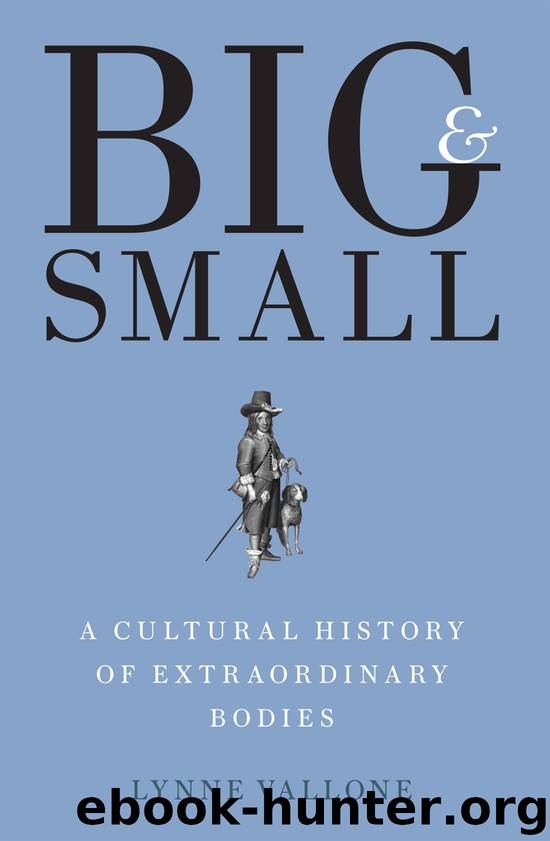Big and Small: A Cultural History of Extraordinary Bodies by Lynne Vallone

Author:Lynne Vallone [Vallone, Lynne]
Language: eng
Format: epub
ISBN: 9780300228861
Google: YE87DwAAQBAJ
Amazon: 0300228864
Publisher: Yale University Press
Published: 2017-01-15T00:40:56.644000+00:00
“Science Finds, Industry Applies, Man Conforms”
Behind big machines lie big ideas. And animating these ideas were the desires to reduce human labor, solve agricultural, industrial, transportation, and communication problems, increase efficiency and profits as well as to entertain. Innovations in science and technology lay claim to many of the machines built to answer these desires, machines that were showcased in expositions and world’s fairs from the mid-nineteenth century forward. Among other purposes such as bringing the world “home” via the exhibition of native peoples from around the globe, as I discussed in the previous chapter, world’s fairs also advertised and celebrated the host nation’s progress in research, development, and design. Indeed, the world’s fair was a stage upon which new inventions with far-reaching social implications were launched: for example, the Colt revolver (London, 1851), telephone (Philadelphia, 1876), motion picture (Paris, 1900) and the ice cream cone (St. Louis, 1904). World’s fairs of the late nineteenth and early twentieth centuries were nationalistic, commercial, and cultural ventures, undertaken to assuage social anxieties and economic worries, as well as to make money for their shareholders. For example, the 1933–1934 Chicago World’s Fair, a century-of-progress exposition, celebrated Chicago’s centennial while at the same time it promoted both business interests and spectacle. The fair’s motto—“science finds, industry applies, man conforms”—made perfectly evident its focus on elevating industry’s status to that of science. And man? Man “conforms” to the dictates of both.
The century-of-progress international exposition took place in 1933 and 1934, the mid-point of what would become known as “the Great Depression” and after FDR’s morale-boosting landslide victory in 1932. The exposition was years in the making, however, and its planning necessarily had begun long before opening day. In fact, the fair was conceived and organized during the worst of the Depression when unemployment rose precipitously, banks failed and desperate Americans struck, marched, and rioted. Who could have thought that an expensive World’s Fair was a good idea while so many Americans were hungry and suffering? The answer: a think tank of prominent scientists, industrialists, engineers, philanthropists, and politicians.
According to Robert W. Rydell, the foremost authority on American world’s fairs, fueled by a common belief that uniting science and business could help to relieve the economic crisis that threatened America’s global reputation and what was perceived to be the American way of life, scientists and industrialists together settled on a world’s fair as a way to educate the average American about the importance of technology and corporate values to a successful American future:
There was more to the fan dance of science than met the eye. It was part of the persistent effort by American scientists after World War 1 to popularize science, mold a ‘true’ American culture with scientific values, and affirm the hegemony of the corporate state. These efforts continued through the 1920s and intensified in the 1930s as scientists, confronted by a ‘revolt against science,’ joined corporate backers of the fairs in trying to pin popular hopes for national recovery on the positive results expected from the fusion of science and business.
Download
This site does not store any files on its server. We only index and link to content provided by other sites. Please contact the content providers to delete copyright contents if any and email us, we'll remove relevant links or contents immediately.
| African-American Studies | Asian American Studies |
| Disabled | Ethnic Studies |
| Hispanic American Studies | LGBT |
| Minority Studies | Native American Studies |
Cecilia; Or, Memoirs of an Heiress — Volume 1 by Fanny Burney(32437)
Cecilia; Or, Memoirs of an Heiress — Volume 2 by Fanny Burney(31873)
Cecilia; Or, Memoirs of an Heiress — Volume 3 by Fanny Burney(31857)
The Great Music City by Andrea Baker(31488)
We're Going to Need More Wine by Gabrielle Union(18972)
All the Missing Girls by Megan Miranda(15585)
Pimp by Iceberg Slim(14397)
Bombshells: Glamour Girls of a Lifetime by Sullivan Steve(13977)
Talking to Strangers by Malcolm Gladwell(13227)
Norse Mythology by Gaiman Neil(13211)
Fifty Shades Freed by E L James(13158)
For the Love of Europe by Rick Steves(13049)
Mindhunter: Inside the FBI's Elite Serial Crime Unit by John E. Douglas & Mark Olshaker(9206)
Crazy Rich Asians by Kevin Kwan(9170)
The Lost Art of Listening by Michael P. Nichols(7411)
Enlightenment Now: The Case for Reason, Science, Humanism, and Progress by Steven Pinker(7239)
The Four Agreements by Don Miguel Ruiz(6636)
Bad Blood by John Carreyrou(6555)
Weapons of Math Destruction by Cathy O'Neil(6148)
